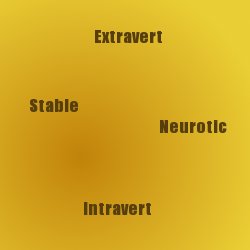One identity?
I ran across the following quote from Mark Zuckerberg the other day -- not for the first time -- but this time my initial response, instead of being some disgruntled mumbling about Facebook's privacy settings, was how Western.

"You have one identity. The days of you having a different image for your work friends or co-workers and for the other people you know are probably coming to an end pretty quickly... Having two identities for yourself is an example of a lack of integrity." --Mark Zuckerberg
Why Western?
Richard Nisbett on Geography, ecology, philosophy
Last semester, I read a book called The Geography of Thought: How Asians and Westerners Think Differently...and Why by Richard Nisbett. As you may infer from the book's title, Nisbett talks about all kinds of differences in Western versus East Asian cultures and why those differences exist -- and I mean all kinds. It's a broad book. I'm going to give you the flavor:
Nisbett starts by outlining differences in philosophy. Greek philosophy took as a fundamental principle that matter divides into discrete objects. The Greeks drew a line between the internal and external, essentially inventing nature. Perhaps this was a result of their culture of debate, which relies on the notion that two minds can have different representations of the world and that the world has its own nature independent from both minds. Western cultures grew out of Greek philosophy. Since boundaries between any object and its surroundings were built in, people were discrete. Westerners emphasize individualism. The focus on objects and individuals may have led to many of dualisms we have encountered this semester.
Ancient Chinese philosophy, on the other hand, bespoke a constantly changing world, full of contradictions and moving in endless cycles. Harmony and holism were emphasized: there was a mutual influence of everything on everything else. Chinese has no abstractness, either; no “whiteness” without a thing that is white – the white of a swam, the white of the snow. People defined themselves in relation to others, interdependent rather than independent; the goal was The Way rather than truth or knowledge.

Some of these differences may have arisen in part from the ecology in which the cultures developed. Greece was a maritime location where people of many customs and beliefs were encountered, a city-state where rational argument was king, and curiosity and knowledge were valued for their own sake. Occupations favored the autonomous individual – herding, hunting, trading, fishing. Intellectual rebels could move cities to retain the ability for free inquiry, and the clashing of so many customs may have led to the development of formal logic to help deal with the frequent contradiction of opinion. In contrast, the Chinese population by and large belongs to the same ethnic group. Rarely were people with different beliefs and customs encountered, and because many people were farmers who depended on joint irrigation, agreed-upon norms and harmony with one's neighbors were the goal. From Nisbett's discussion, one might infer that it is the ecology that led to the development of these features of culture in the first place.
Assumptions about individualism - and language's role
Nisbett also talks about assumptions. Westerners, he says, consider people to be individuals, assuming that everyone is in control of his/her own behavior, oriented toward goals, striving to be different from everyone else, and preferring justice to be blind. This is Zuckerberg's assumption, in his above quote.
But not everyone thinks that way. Nisbett notes that East Asians tend to be more concerned with coordinated action and group goals, fitting in, and negotiating a “middle way” that will satisfy particular disagreeing parties. In Confucian philosophies, man cannot exist alone. This has interesting implications for how people understand themselves and how a self-concept is developed! East Asians tend to think that people are defined by their relationships to other people. This is reflected in their languages: Chinese has no word for “individualism” and Japanese has many “I” words, using different words to refer to the self in relation to parents, friends, or professors. East Asians, when describing themselves, refer to their social roles and find it difficult to not specify situations and contexts. Westerners explain personality traits, role categories, and activities – none of which are solely dependent on context.

What I wondered, while reading, was this: How does cultural emphasis on individualism versus collectivism change a person's concept of self? Fivush & Nelson (PDF) (2004) suggested that autobiographical memory and a concept of self are partially developed through an awareness of self versus other. Wang & Ross (2007) proposed that language is very important to autobiographical memory, and Ratcliffe (2007) suggested that a person might learn to distinguish the self as an individual through interactions with others – but Ratcliffe is a Westerner! Do Westerners build up a concept of self in a different way than East Asians? Does the fact that people who speak certain East Asian languages have few if any explicit ways to refer to individualism or to an “I” without reference to other people influence them to conceive of themselves in a more relational, collectivist way? This points to a deeper question: How much do people's languages impact their thoughts, conceptions, beliefs, and perceptions? Nisbett presented examples of how language might change how we think about the world around us. E.g., Westerners tend to learn nouns faster – nouns are objects, inert, and tend to be emphasized more in parent-child conversations. Verbs, which are reactive and about relationships, are more salient in East Asian languages. The properties of the language and how the language is used help drive the object versus relation and individual versus collective dichotomies we see across cultures. Again, I see the same paradoxical question: which came first, the language, or the concepts? How and why did these language differences originally evolve?
An interesting question here, with regards to the role of language priming for certain ways of thought, and differences in memory and recall, is this: Do people focus on things (such as objects, situations, and contexts) because they regard them as causally important, or do they regard them as casually important because they focus on them? Regardless of which statement is more true – and perhaps neither is – this statement highlights the role of interpretation. Nisbett discussed a study in which American students were primed to think either interdependently or independently. Students primed for independence rated individualist values as higher and collectivist values as lower; if primed for interdependence, the opposite was true. In an unprimed condition, American students rated individualist values higher while Hong Kong students rated collectivist values higher – but if primed for either case, all the students showed the aforementioned trend. This is interesting because Westerners, in their everyday lives, are constantly being primed as individuals, while East Asians are being primed with interdependence cues. Nisbett offers anecdotes of people who switched locations in the world and subsequently started behaving more independently or interdependently. Context matters!
Harmony vs agency

Nisbett also explains the ideas of erabi and awase. Erabi is active, agentic: the idea that people can freely manipulate their environments to suit their own purposes. Awase is harmonious, fitting in: the idea that people adjust themselves to their environments rather than trying to change them. The Western versus East Asian dichotomy is clear here. Are Westerners resistant to context-based models of the world, to theories such as Pentland's (2007) that language may not do as much as we think, and to the general idea that individuals are subject to external forces and influences because of their erabi style? Perhaps this is also why the illusion of conscious will is so appealing – do Westerners have more of an obsession with free will than do East Asians? Nisbett notes later than East Asians report feeling less in control of their lives than do Westerners, but that they have less of an issue with this – instead of trying to control situations, they try to adjust them. East Asians also tend to be less susceptible to illusions of control than Westerners.
I am reminded of a quote from Nikos Kazantzakis: “Since we cannot change reality, let us change the eyes that see reality.” It puts me in mind of expectations. Peoples' experiences set up their expectations about significance and meaning of future experiences – their culture influences what experiences they have. The same events don't mean the same thing to everyone. In the context of this person's experiences so far, different events may have been encountered more frequently, different behaviors may have been encouraged or discouraged, and different values emphasized. Nisbett (2003) discusses several studies that suggested East Asians are not as surprised by unexpected outcomes as are Westerners. This could be because they are more accepting of change to begin with – their world view anticipates that no situation will stay constant. Westerners, on the other hand, presume linearity of trends – the fact that they predict a trend to continue in its same direction could lead to their greater surprise when that prediction turns out to be false.
In sum: Agent, environment
In summary: Culture constantly surrounds us. It shapes how the people we interact with react to and interpret their environments, which in turn shape how they interact with us and what they emphasize in those interactions. It shapes and is shaped by language; language shapes and is shaped by our expectations and experiences. We have to keep in mind, however, that cultural differences are averages. Nisbett is careful to note this. Any individual person may not conform to the cultural norms. Although culture is a remarkably important context for a human, the development of a person in a culture is not quite so set as a cell being cultured in a petri dish. It is still the dynamic interactions between genes and an environment that develop a phenotype -- an agent plus an environment. The environment, for a person, includes that person's culture. A person's past experiences with aspects of their culture – e.g., parent speaking styles, emphasis on objects versus relations, language – will influence that person's present behavior. Oyama (2000a, 2000b) said we cannot attribute development solely to genes. Neither can development be attributed solely to culture, nor to the wider environment. It is through the interaction of all these contexts that we get functioning organisms.
References
Fivush, R. & Nelson, K. (2004) Culture and Language in the Emergence of Autobiographical Memory. Psychological Science, 15 (9), 573 – 577. [PDF]
Nisbett, R. (2003). The Geography of Thought. New York, NY: Free Press.
Oyama, S. (2000a). Evolution's Eye: A Systems View of the Biology-Culture Divide. Durham, NC: Duke University Press.
Oyama, S. (2000b). The Ontogeny of Information: Developmental Systems and Evolution. Durham, NC: Duke University Press.
Pentland, A. (2007). On the collective nature of human intelligence. Adaptive Behavior, 15 (2), 189-198. [PDF]
Ratcliffe, M. (2007). Rethinking Commonsense Psychology. New York, NY: Palgrave MacMillian.
Wang. Q., & Ross, M. (2007). Culture and Memory. In S. Kitayama & D. Cohen, (Eds.), Handbook of Cultural Psychology (pp. 645-667). New York, NY: The Guilford Press.








